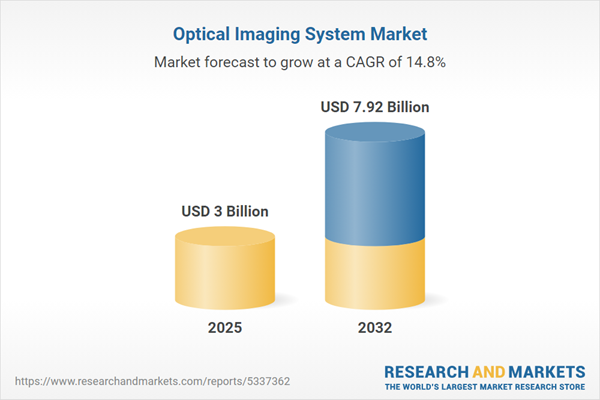Speak directly to the analyst to clarify any post sales queries you may have.
The optical imaging system market is becoming an essential pillar for organizations seeking to modernize operations, manage risk, and steer strategic initiatives within rapidly changing digital landscapes. As digital transformation accelerates, robust optical imaging solutions are establishing themselves as key assets across industries, supporting the shift toward data-driven and agile enterprise environments.
Market Snapshot: Optical Imaging System Market Growth Outlook
The global optical imaging system market is on a steady upward trajectory, with a reliable compound annual growth rate projected through 2032. This momentum is driven by increasing organizational investment in advanced digital imaging platforms engineered to elevate operational precision. Integration of sophisticated software and algorithmic solutions is enabling efficient data handling and timely decision-making. The optical imaging system market maintains resilience by adapting to evolving regulatory demands and serving diverse operational needs across major world regions. Underpinning technology investments is an enterprise-wide focus on compliant, responsive infrastructure designed to address new market challenges and expectations.
Scope & Segmentation: Broad Application and Regional Reach
- Medical Applications: Digital optical imaging plays a critical role in healthcare by supporting detailed vascular diagnostics, dental procedures, and minimally invasive interventions. These capabilities enable real-time patient monitoring, facilitate robotic-assisted therapies, and enhance overall quality of care.
- Industrial Applications: Imaging solutions contribute to manufacturing excellence by automating quality control and delivering comprehensive product evaluation. Optical imaging systems help organizations detect defects, advance safety measures, and enforce regulatory compliance, ensuring streamlined manufacturing operations.
- Scientific Applications: Enhanced platforms empower researchers in fields such as astronomy, life sciences, and engineering to achieve greater accuracy through advanced experimental analysis. Research institutions utilize optical imaging to produce actionable data and support reliable scientific outcomes.
- Security Applications: Enterprises and government agencies leverage multi-spectral and hyperspectral imaging for advanced surveillance and improved biometric identification. These technologies equip stakeholders to proactively address dynamic security environments and emerging risks.
- Regional Reach: Adoption remains robust across the Americas, Europe, Middle East, Africa, and Asia-Pacific. Key contributors include the United States, China, Japan, Germany, India, Canada, and Australia, each adapting to unique regional regulations and market trends.
- Key Companies: Leading entities such as Carl Zeiss AG, Nikon Corporation, Olympus Corporation, Leica Microsystems GmbH, Thermo Fisher Scientific Inc., PerkinElmer, Hamamatsu Photonics K.K., Teledyne Technologies, Bruker Corporation, and Keyence Corporation are shaping innovation and strategic collaborations within the sector.
Key Takeaways for Decision-Makers
- Integrating artificial intelligence and machine learning into imaging platforms enhances pattern recognition, which drives improved outcomes for healthcare, research, and manufacturing sectors.
- Advancements in miniaturization are enabling portable optical imaging units, expanding diagnostic and analytical capabilities into remote and resource-constrained environments.
- Spectral and hyperspectral imaging development delivers deeper analytical insights, producing datasets that support sophisticated workflows in biological and material science fields.
- Adoption of modular hardware and software architectures accelerates feature customization, allowing organizations to rapidly align imaging systems with evolving operational needs.
- Sustainability initiatives around materials and system designs are gaining priority, helping enterprises achieve compliance while supporting broader environmental goals throughout operations.
- Building an integrated hardware and software ecosystem elevates collaboration across departments and helps stabilize supply chains, leading to greater consistency in project outcomes.
Tariff Impact: Navigating United States 2025 Policy Adaptations
With changes ahead in United States trade policy for 2025, market participants are addressing supply chain risks by actively diversifying sourcing strategies and enhancing domestic procurement. These efforts strengthen resilience against shifting regulatory and geopolitical landscapes, helping maintain continuity of operations and strategic planning despite uncertainty.
Methodology & Data Sources
The insights presented are informed by a blend of expert analysis and quantitative research, integrating data from regulatory documentation, patent filings, academic studies, and direct supplier interviews. This multifaceted approach ensures relevance for senior leaders seeking actionable perspectives.
Why This Report Matters for Senior Decision-Makers
- Delivers a comprehensive overview of technological evolutions, regulatory shifts, and supply chain adaptations affecting the optical imaging system market.
- Supports the creation of adaptable strategies and operational frameworks, empowering organizations to address market change and realize emerging collaborative opportunities.
- Enhances executive decision-making with strategic intelligence designed to facilitate risk mitigation and long-term growth in dynamic global environments.
Conclusion
This report provides executives with clear, actionable insights for navigating the complexities of the optical imaging system market, aiding in confident planning and effective growth strategy development.
Additional Product Information:
- Purchase of this report includes 1 year online access with quarterly updates.
- This report can be updated on request. Please contact our Customer Experience team using the Ask a Question widget on our website.
Table of Contents
3. Executive Summary
4. Market Overview
7. Cumulative Impact of Artificial Intelligence 2025
List of Figures
Companies Mentioned
The companies profiled in this Optical Imaging System market report include:- Carl Zeiss AG
- Nikon Corporation
- Olympus Corporation
- Leica Microsystems GmbH
- Thermo Fisher Scientific Inc.
- PerkinElmer, Inc.
- Hamamatsu Photonics K.K.
- Teledyne Technologies, Inc.
- Bruker Corporation
- Keyence Corporation
Table Information
| Report Attribute | Details |
|---|---|
| No. of Pages | 194 |
| Published | November 2025 |
| Forecast Period | 2025 - 2032 |
| Estimated Market Value ( USD | $ 3 Billion |
| Forecasted Market Value ( USD | $ 7.92 Billion |
| Compound Annual Growth Rate | 14.8% |
| Regions Covered | Global |
| No. of Companies Mentioned | 11 |









